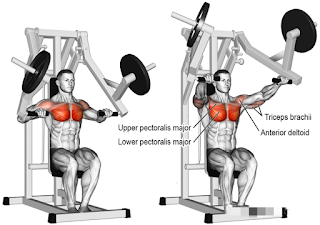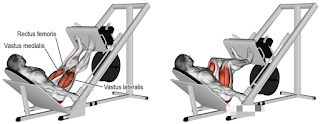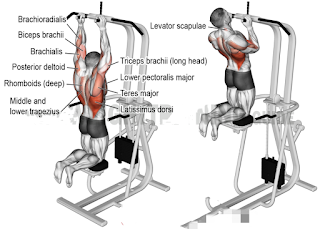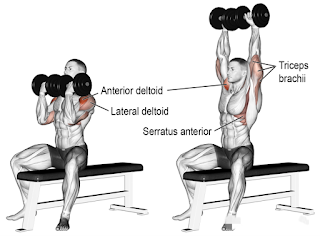The full-body training program
My first attempt at a total-body training program has been after I got my NSCA-CPT certification, and I personally feel that for the average fitness enthusiast, this is the best training program. Whether you have no training experience, full-body training is the best way to build muscle, gain strength and lose fat.
Full body training not only regulates the frequency of training and helps the body recover, but also saves more time. You only need to train three times a week. Each time you go to the gym to mobilize the majority of muscle groups for training and follow the principle of balanced muscle development, the muscle can be more proportional to the gradual growth, so that not only can develop a better-looking body, but also reduce the risk of injury.
The whole body training program is based on compound movements, because more muscles can be involved, accompanied by some auxiliary training to avoid muscle imbalance.
The core movements of the total body training program
The first movement
Barbell bench press ( dumbbell bench press)
The barbell bench press is the main chest movement, it is important to make the chest bigger and thicker by this movement. Specifically, because the training bench is flat, it can focus on training to the middle of the chest, but also promote the development of the shoulders and triceps.
When doing this action, mainly feel the chest force. In most cases, a large bench press weight will result in large pectoral muscles. Bench press, the barbell needs to touch the chest to complete the whole action, will do the whole action is more conducive to muscle growth. Therefore, unless you can't do the full range of motion because of a shoulder injury, it's better to do the full range of motion for the bench press for the best results.
Replacement of fixed equipment.
The second movement
Barbell squat
For lower body training, the barbell squat is the first choice. Many studies have proven that the barbell squat is very effective in stimulating the quadriceps, as well as mobilizing the gluteus maximus and other muscles of the lower body. When doing barbell squats, it is equally important to do the full length of the squat to maximize muscle growth.
Although the standard of the full movement may not be the same due to the different physical flexibility of each person. I recommend still squatting deep with your thighs at least parallel to or slightly below the ground, and if you have higher joint flexibility, you can also squat deeper with safety in mind.
Replacement of fixed apparatus.
The third movement
Pull-ups
A very important movement for upper body training is the pull-up, which is also the main back movement in total body training. The main muscle used here is the latissimus dorsi, but also to train the shoulder and scapular stabilizing muscles, as well as the biceps and forearm muscles.
When doing this movement, the main thing is to feel the contraction of the latissimus dorsi. If you can already complete 10-12 self-weight pull-ups, you can start trying weights, either using a weight belt or holding dumbbells with your feet. If you can't do pull-ups, you can use elastic bands or equipment to assist, or you can do the centrifugal portion of pull-ups, which are good options to slowly strengthen until you can successfully complete self-weighted pull-ups.
Assisted fixed apparatus.
The fourth movement
Prone leg curl
Prone leg curl, pay attention to the centrifugal for weight control. This movement is aimed at the hamstrings, each repetition should be careful to feel the hamstring force, the abdominal muscles must be tightened to prevent the lower back force.
This action is added to further strengthen the hamstrings because only doing behind-the-neck barbell squat is far from activating the hamstrings, the activation level is only about 27%, lower than other hamstring movements. To prevent injury, the hamstrings and quadriceps should be kept in balance.
Hamstrings doing centrifugal movements are very helpful in improving performance and preventing injury, which means doing this movement with conscious weight control and keeping the movement slow each time you go down.
Be aware that these training movements can lead to muscle soreness after training, and I recommend taking your time with the weight and progressing gradually.
The fifth movement
Standing barbell overhead press
Standing barbell overhead press, this movement is very important for the upper body muscle building and strength. This movement mobilizes the whole body muscles, the main exercise muscles are deltoids, triceps, and front serratus. This is also the best movement to train the deltoids. Compared to other shoulder presses, this movement lifts the most weight. From a practical point of view, it is also the easiest movement for progressive load training of the shoulder.
The seated dumbbell press has the same activation effect, depending on your choice, which movement is more comfortable to practice.
Alternative movements: Arnold push-ups
Note: barbell movements can be replaced with dumbbells; for newcomers, they can also be replaced with fixed equipment with the same movement pattern.
Full-body training assistance movements
The first assisted movement
Face pull
The face pull is an important movement for shoulder health and body shape, and it can also balance the various pushing movements in this training. This movement mainly uses the lower and middle trapezius and rotator cuff muscle groups.
The face pull should keep the elbows elevated and move the elbows back while pulling the rope towards the face. At the end of the movement, the shoulder is externally rotated, so that the movement can most effectively stimulate the rotator cuff muscle group and deltoid muscle.
I highly recommend choosing a lighter weight and paying primary attention to activating the target muscles.
The second assisted movement
Drag curl
The drag curl also includes shoulder extensions and will train the long head of the biceps, or the lateral head of the biceps. Simply use a fixed weight barbell or barbell bar and lift the barbell as close to the body as possible by moving the elbows to the back of the body. The same applies when lowering the barbell. In terms of weight selection, I recommend choosing a weight that is 50% heavier than you would normally do for a standard two-headed curl, perfecting the movement first before adding weight.
The third auxiliary movement
Curl-ups
The curl-ups must be focused on the abdominal curl, shoulder blades lift off the ground on it, do not curl your cervical spine, will cause discomfort in the neck.
The full-body training program
Full-body training is usually an alternation of an upper-body movement and a lower body movement, which helps improve recovery speed and training performance for each movement.
Basic training sequence.
1, bench press 2, deep squat 3, pull-up 4, prone leg curl 5, standing push-up
Auxiliary movements add one per training.
Action repetitions: 8-12 times
Number of groups: 3-6 sets of each action
Training frequency: 3 times a week, every other day of training.
Special reminder: do not need to do each group exhaustion
The order of movements can be adjusted according to the focus of training. Because the earliest few movements, often better results, can be completely rearranged according to their needs action order. For example, you want to focus on improving pull-up strength and back muscle gain, then your first action can be a pull-up, not necessarily a barbell bench press.
Personal opinion: for newcomers to fitness, you can take a full-body training program in the first two years of fitness to refine the technology, to maintain the overall development of the body, and the benefits will certainly be higher than the divided training; for advanced trainers, if you have not tried full-body training, with 8 weeks to try it, may have a different feeling.











No comments:
Post a Comment